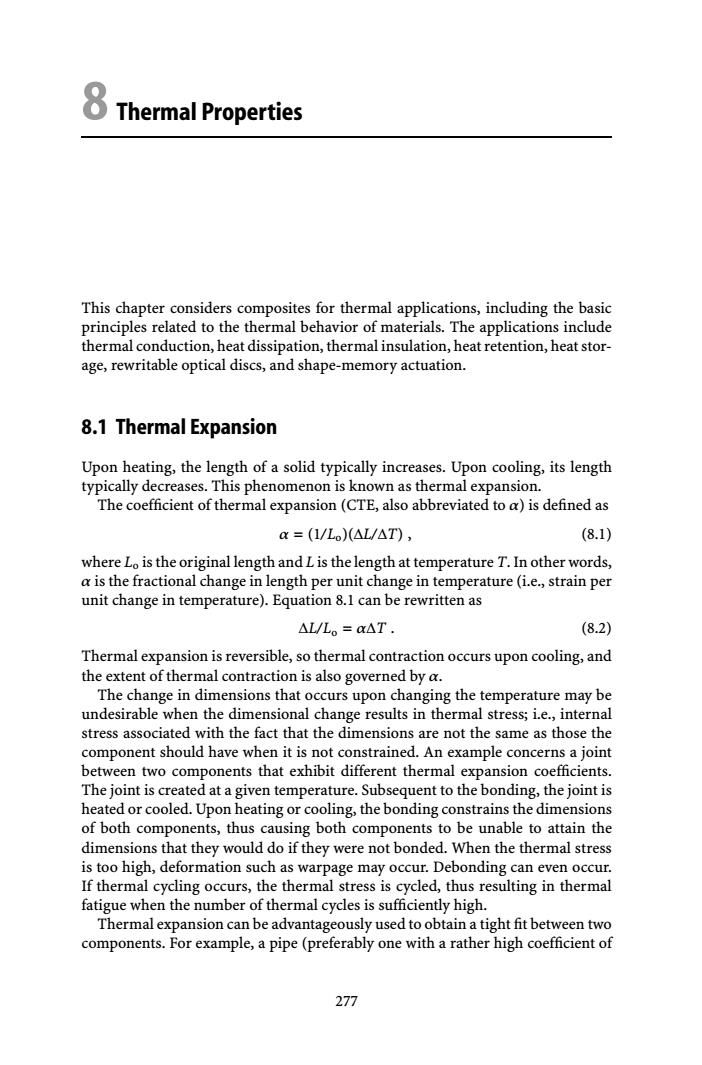正在加载图片...

8 Thermal Properties This chapter considers composites for thermal applications,including the basic principles related to the thermal behavior of materials.The applications include thermal conduction,heat dissipation,thermal insulation,heat retention,heat stor- age,rewritable optical discs,and shape-memory actuation. 8.1 Thermal Expansion Upon heating,the length of a solid typically increases.Upon cooling,its length typically decreases.This phenomenon is known as thermal expansion. The coefficient of thermal expansion(CTE,also abbreviated to a)is defined as a=(1/Lo)(△L/△T), (8.1) where Lo is the original length and L is the length at temperature T.In other words, a is the fractional change in length per unit change in temperature(i.e.,strain per unit change in temperature).Equation 8.1 can be rewritten as △L/L。=AT. (8.2) Thermal expansion is reversible,so thermal contraction occurs upon cooling,and the extent of thermal contraction is also governed by a. The change in dimensions that occurs upon changing the temperature may be undesirable when the dimensional change results in thermal stress;i.e.,internal stress associated with the fact that the dimensions are not the same as those the component should have when it is not constrained.An example concerns a joint between two components that exhibit different thermal expansion coefficients. The joint is created at a given temperature.Subsequent to the bonding,the joint is heated or cooled.Upon heating or cooling,the bonding constrains the dimensions of both components,thus causing both components to be unable to attain the dimensions that they would do if they were not bonded.When the thermal stress is too high,deformation such as warpage may occur.Debonding can even occur. If thermal cycling occurs,the thermal stress is cycled,thus resulting in thermal fatigue when the number of thermal cycles is sufficiently high. Thermal expansion can be advantageously used to obtain a tight fit between two components.For example,a pipe(preferably one with a rather high coefficient of 2778 Thermal Properties This chapter considers composites for thermal applications, including the basic principles related to the thermal behavior of materials. The applications include thermal conduction, heat dissipation, thermal insulation, heat retention, heat storage, rewritable optical discs, and shape-memory actuation. 8.1 Thermal Expansion Upon heating, the length of a solid typically increases. Upon cooling, its length typically decreases. This phenomenon is known as thermal expansion. The coefficient of thermal expansion (CTE, also abbreviated to α) is defined as α = (1/Lo)(ΔL/ΔT) , (8.1) where Lo is the original length and L is the length at temperature T. In other words, α is the fractional change in length per unit change in temperature (i.e., strain per unit change in temperature). Equation 8.1 can be rewritten as ΔL/Lo = αΔT . (8.2) Thermal expansion is reversible, so thermal contraction occurs upon cooling, and the extent of thermal contraction is also governed by α. The change in dimensions that occurs upon changing the temperature may be undesirable when the dimensional change results in thermal stress; i.e., internal stress associated with the fact that the dimensions are not the same as those the component should have when it is not constrained. An example concerns a joint between two components that exhibit different thermal expansion coefficients. The joint is created at a given temperature. Subsequent to the bonding, the joint is heated or cooled. Upon heating or cooling, the bonding constrains the dimensions of both components, thus causing both components to be unable to attain the dimensions that they would do if they were not bonded. When the thermal stress is too high, deformation such as warpage may occur. Debonding can even occur. If thermal cycling occurs, the thermal stress is cycled, thus resulting in thermal fatigue when the number of thermal cycles is sufficiently high. Thermal expansion can be advantageously used to obtain a tight fit between two components. For example, a pipe (preferably one with a rather high coefficient of 277